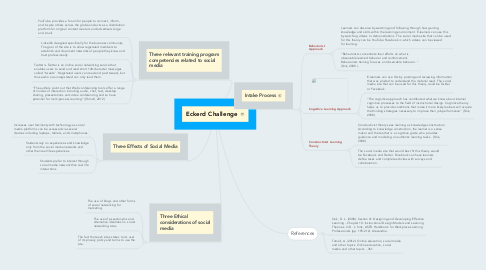
1. Three Effects of Social Media
1.1. Increases user familiarity with technology as social media platforms can be accessed via several devices including laptops, tablets, and smartphones.
1.2. Students rely on experiences and knowledge only from the social media networks and other then real life experiences.
1.3. Students prefer to interact through social media network than real life interactions.
2. Three Ethical considerations of social media
2.1. The use of blogs and other forms of social networking for marketing.
2.2. The use of pseudonyms and alternative identities on social networking sites.
2.3. The fact that each sites states to its user of its privacy policy and terms to use the site.
3. Three relevant training program competencies related to social media
3.1. YouTube provides a forum for people to connect, inform, and inspire others across the globe and acts as a distribution platform for original content creators and advertisers large and small.
3.2. LinkedIn designed specifically for the business community. The goal of the site is to allow registered members to establish and document networks of people they know and trust professionally.
3.3. Twitter is Twitter is an online social networking service that enables users to send and read short 140-character messages called "tweets". Registered users can read and post tweets, but those who are unregistered can only read them.
3.4. "The authors point out that Web conferencing tools offer a range of modes of interaction including audio, chat, text, desktop sharing, presentations and video conferencing and so have potential for multi-process learning" ((Tatnall, 2012)
4. Intake Process
4.1. Behaviorist Approach
4.1.1. Learners can observe by watching and following through how gaining knowledge and skills within the learning environment. E-learners can use this by watching videos or demonstrations. The social media site that can be used for this theory can be YouTube Facebook in which videos can be viewed for learning.
4.1.2. "Behaviorists concentrate their efforts on what is observable learned behavior and reinforcement. Behaviorists training focuses on observable behavior. " (Sink, 2008 ).
4.2. Cognitive Learning Approach
4.2.1. E-learners can use this by posting and reviewing information that was posted to understand the material read. The social media site that can be used for this theory could be Twitter or Facebook.
4.2.2. "The cognitive approach has contributed what we know about internal cognitive processes to the field of instructional design. Cognitive theory helps us to provide conditions that make it more likely learners will acquire the thinking strategies necessary to improve their job performance" (Sink, 2008).
4.3. Constructivist Learning Theory
4.3.1. Constructivist theory sees learning as knowledge construction. According to knowledge construction, the learner is a sense maker and the teacher is a cognitive guide who provides guidance and modeling on authentic learning tasks.. (Sink, 2008).
4.3.2. The social media site that would best fit this theory would be Facebook and Twitter. Facebook can have learners define tasks and complete activites with surveys and collaboration.
